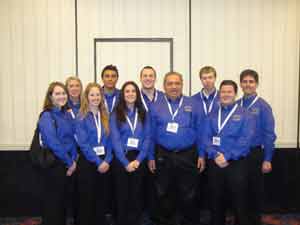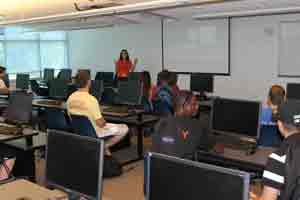Courses
Graduate
Instructor to BCN6785: Construction Information Systems: Spring 2009-Present
In my second semester of the PhD program, I was given the opportunity to teach a graduate elective course on the integration of technology in construction. Over the past 3 years, I have slowly revised the curriculum to emphasize the fundamentals of Building Information Modeling (BIM) and Virtual Design and Construction (VDC) in the contruction context. Therefore, 70% of the course presents application of various software tools including: Autodesk’s Revit Architecture, Structure, MEP and Navisworks in a lab setting. Students are taught how to author multi-disciplinary as-built construction models and then utilize the models for construction estimating, secheduling and coordination. The other 30% of the course presents lecture material on the theoretical principals of BIM and case studies of successful BIM usage delivered by guest lectures from industry leaders.Though challenging, I am extremely grateful I was given the opportunity to build my own curriculum. It was an excellent learning experience. For this course, I was responsible for creating all assignments, labs, exams, and teaching materials. To aid in learning fundamentals, I developed a set of detailed curriculum standard building plans, a semester long group project in which students are given the opporuntity to work with students from other disciplinesas well a variety of online content to reinforce lab material in learning the software. Click below to view a sample lecture of online content I have developed using camtasia studio 7.0.
BCN6785 is traditionally taught in the Spring semester of each academic year. There are generally 30 seats available. If you are interested in learning more about the course content, view the Course Syllabus [PDF 56 kb].
Undergraduate
Teaching Assistant to BCN3255: Computer and Graphic Communications: Spring 2010-Present
Since my second year in the PhD program, I have also been a lab instructor to an undergraduate course on construction documentation. The course introduces students to various construction communication tools including print reading; computer aided drafting (CAD), and building information modeling (BIM). Its primary objective is to help students understand how to apply these communication tools to successfully manage the construction process. My responsibilities for this course included assisting in the lab once a week to answer student questions regarding software and the basics of construction documentation.Coach to UF BIM Competition Team: 2009-Present
 Each academic year, I assist in training a team of undergraduate students in preparation for the Annual ASC Regions 6 and 7 Student BIM Competition in Reno, NV. It is the only national student competition in existence which is specific to BIM. We meet weekly in the evenings to review BIM applications to construction management. I have developed a training schedule as well as various exercises to help prepare them for the national competition which takes place each Spring semester.In 2010 the team won 2nd place in the competition. We are hoping to achieve that same success in the future.
Each academic year, I assist in training a team of undergraduate students in preparation for the Annual ASC Regions 6 and 7 Student BIM Competition in Reno, NV. It is the only national student competition in existence which is specific to BIM. We meet weekly in the evenings to review BIM applications to construction management. I have developed a training schedule as well as various exercises to help prepare them for the national competition which takes place each Spring semester.In 2010 the team won 2nd place in the competition. We are hoping to achieve that same success in the future.
Teaching Assistant to IND3483: Interior Design Construction Documents: Fall of 2007
During my first semester of graduate school, I was asked by a former professor to assist in teaching an undergraduate course on construction documentation to junior level interior design students. My responsibilities included: assisting students with learning AutoCAD and the comprehension and preparation of construction documents. For this course, I answered questions during their weekly lab and graded course assignments. That was my first experience teaching in higher education.Continuing Education Seminars
 Finally, as a part of my job at University of Florida's Center for Advanced Construction Information Modeling (CACIM):, I occasionally assist in instructing continuing education coursework for members of the construction industry. These courses are day-long seminars which introduce industry professionals to some of the principals of using BIM software tools. Topics include: an overview of multidisciplinary workflow, entry level modeling practices, model based quantity takeoffs and estimation, construction sequencing, and clash detection.
Finally, as a part of my job at University of Florida's Center for Advanced Construction Information Modeling (CACIM):, I occasionally assist in instructing continuing education coursework for members of the construction industry. These courses are day-long seminars which introduce industry professionals to some of the principals of using BIM software tools. Topics include: an overview of multidisciplinary workflow, entry level modeling practices, model based quantity takeoffs and estimation, construction sequencing, and clash detection.
I have found the experience to be much more challenging than teaching at the graduate and undergraduate level because of the pace of the seminars and the level of computer literacy of the student population. However, I am grateful to have been given the opportunity to understand the different pedagogical methods required for adult education.
